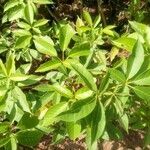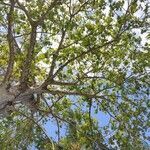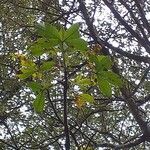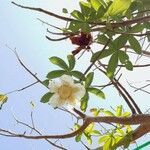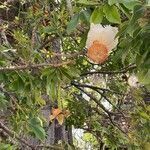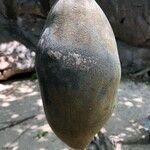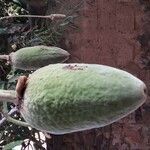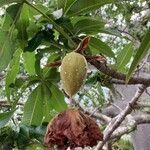Usually massive deciduous trees reaching 25 m in height and up to 10 m diam., with single or multiple, cylindrical or fluted, often buttressed trunks and spreading, rounded crowns. Branches irregularly distributed, massive. Bark gray, smooth to irregularly tuberculate. Leaves 5-7(-9)-foliolate; petioles pubescent or glabrous; stipules caducous; leaflets sessile to subsessile, varying greatly in size, medial leaflet 5-15 x 3-7 cm, usually elliptic-obovate, with acuminate apices and decurrent bases; glabrous or with simple or clumped hairs; margins entire. Flowers produced during dry or wet season; buds globose with an acute-conical apex, solitary, rarely paired; flower stalk pendulous, 15-90 cm long. Calyx lobes (3-)5, triangular, green and tomentose to scabrous outside, cream and villous within, reflexed, 5-9 x 3-5 cm, fused into a broad (5 cm diam.) disc below. Petals white, crumpled in bud, broadly obovate, approximately equal in length to breadth, 4-8 x 4-8 cm, narrowing to a thickened base. Androecium white, comprising a 3-6-cm cylindrical or tapering staminal tube, surmounted by 720-1600 free filaments, ± equal in length to the staminal tube. Ovary conical-ovoid or globose with a thick indumentum of upward-pointing hairs; 7-9 deeply intruded placentae. Style white, bent over at right angles or rarely straight; densely villous below, glabrous above, fitting loosely into staminal tube and persisting after floral abscission. Stigma white with irregular lobes. Fruit variable; globose to ovoid to oblong-cylindrical, calyx lobes persistent or caducous; pericarp up to 8-10 mm thick, woody, with few embedded longitudinal fibers, covered in a velvety indumentum of yellow-brown or greenish hairs. Seeds reniform, laterally flattened, 10-13 x 8-10 x 4-5 mm Germination phanerocotylar.
More
A large tree. It grows up to 25 m tall. It loses its leaves during the year. The branches are thick, angular and spread out wide. The trunk is short and stout and can be 10-14 m around. Often the trunk has deep grooves or is fluted. The bark is smooth and grey but can be rough and wrinkled. The leaves spread out like fingers on a hand. There are 5-9 leaflets. Often the leaves are crowded near the ends of branches. The flowers are large and 12-15 cm across. The petals are white and the stamens are purple. The fruit hangs singly on a long stalk. The fruit has a woody shell. This can be 20-30 cm long and 10 cm across. On the outside of the fruit are green to brown hairs. Inside the fruit are hard brown seeds. They are about 15 mm long. The seeds are in a yellow white floury pulp. The pulp is edible. The thick roots end in fattened tubers.
Tree, up to 20 m high. Flowers large, 48-150 mm long. Calyx deeply 5-lobed. Stamens numerous. Fruit indehiscent, with floury acid pulp. Flowers white.
It is a tropical plant. It grows in the lowlands. It grows in the hot dry regions of tropical Africa. It grows in the Sahel. It survives well in dry climates. It grows where rainfall is 100-1,000 mm a year. It can tolerate fire. It grows where the annual temperatures are between 20°C and 30°C. In most places it grows below 900 m altitude but occasionally grows to 1500 m altitude. It requires good drainage. It can grow in arid places. It grows in Miombo woodland in Africa. It suits hardiness zones 11-12. In Brisbane Botanical Gardens.
More
Characteristic of thorn woodlands of the African savannahs, which are characterized by low elevations with 4-10 dry months a year split into 1 or 2 periods.
The young leaves are eaten as a cooked vegetable. The dried leaves are also used to thicken soups. The fruit pulp is eaten raw. It is also used for a drink. The flowers are eaten raw or cooked. The seeds can be eaten fresh or dried and ground into flour then added to soups. They yield a cooking oil. The young tender roots are eaten. The fattened root tubers are cooked and eaten. The bark is eaten and the dried leaves are used as flavouring. The shoots of germinating seeds are eaten.
Trees are grown from seed. The seed remain viable for several years but before planting the seeds must be treated to break the hard seed coat. This can be done by soaking the seeds in hot water for several minutes or by cutting the seed coat. Seeds that float in water should not be used. Seeds can be planted in nurseries in plastic bags then transplanted after 6 months. Plants can also be grown by cuttings.
